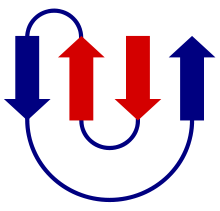Protein topology
Protein topology is a property of protein molecule that does not change under deformation (without cutting or breaking a bond). Two main topology frameworks have been developed and applied to protein molecules: 1) Knot theory which categorises chain entanglements 2) Circuit topology which categorises intra-chain contacts based on their arrangements. The usage of knot theory is however limited to a small percentage of proteins as most of them are unknot. In biology literature, the term topology is also used to refer to mutual orientation of regular secondary structures, such as alpha-helices and beta strands in protein structure [1] . For example, two adjacent interacting alpha-helices or beta-strands can go in the same or in opposite directions. Topology diagrams of different proteins with known three-dimensional structure are provided by PDBsum (an example).

See also
References
- Rawlings, C J; Taylor, W R; Nyakairu, J; Fox, J; Sternberg, M J.E. (1985). "Reasoning about protein topology using the logic programming language PROLOG". Journal of Molecular Graphics. 3 (4): 151–157. doi:10.1016/0263-7855(85)80027-8.